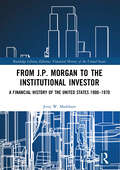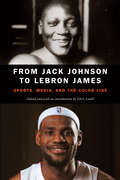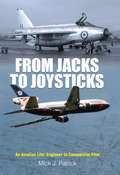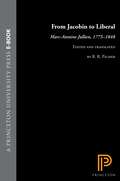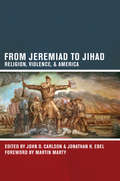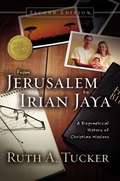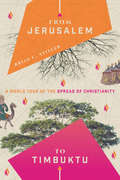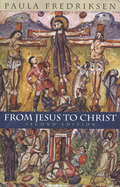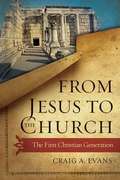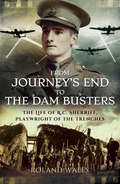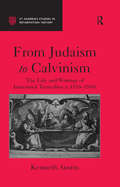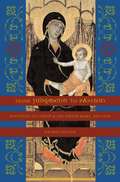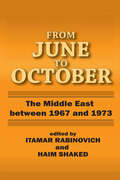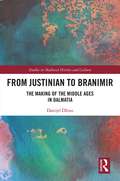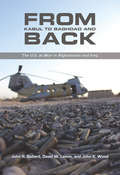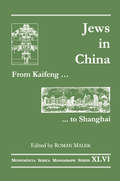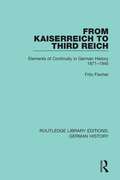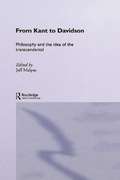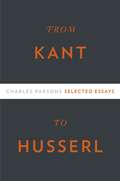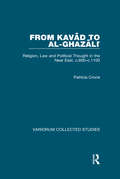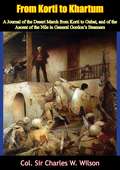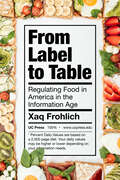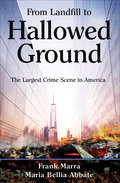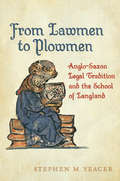- Table View
- List View
From J.P. Morgan to the Institutional Investor: A Financial History of the United States 1900–1970 (Financial History of the United States)
by Jerry W. MarkhamOriginally published in 2002, this is the second of three volumes in a history of finance in America. This volume starts with the investment bankers who dominated finance at the beginning of the twentieth century. It then describes the Panic of 1907 and the resulting creation of the Federal Reserve Board (the 'Fed'). The volume then traces finance through World War I, and it examines the events that led to the stock market crash of 1929 and the Great Depression. From there it reviews the rebirth of finance after World War II and the growth of the institutional investor.
From Jack Johnson to LeBron James: Sports, Media, and the Color Line
by Chris LambThe campaign for racial equality in sports has both reflected and affected the campaign for racial equality in the United States. Some of the most significant and publicized stories in this campaign in the twentieth century have happened in sports, including, of course, Jackie Robinson in baseball; Jesse Owens, Tommie Smith, and John Carlos in track; Arthur Ashe in tennis; and Jack Johnson, Joe Louis, and Muhammad Ali in boxing. Long after the full integration of college and professional athletics, race continues to play a major role in sports. Not long ago, sportswriters and sportscasters ignored racial issues. They now contribute to the public’s evolving racial attitudes on issues both on and off the field, ranging from integration to self-determination to masculinity.From Jack Johnson to LeBron James examines the intersection of sports, race, and the media in the twentieth century and beyond. The essays are linked by a number of questions, including: How did the black and white media differ in content and context in their reporting of these stories? How did the media acknowledge race in their stories? Did the media recognize these stories as historically significant? Considering how media coverage has evolved over the years, the essays begin with the racially charged reporting of Jack Johnson’s reign as heavyweight champion and carry up to the present, covering the media narratives surrounding the Michael Vick dogfighting case in a supposedly post-racial era and the media’s handling of LeBron James’s announcement to leave Cleveland for Miami.
From Jacks to Joysticks: An Aviation Life: Engineer to Commercial Pilot
by Michael John PatrickTrenchard Brat. Flying Spanner. Left Hand Seat. Nicknames abound in aviation. But not many get to be called them all, especially when theyve started life with an aversion to school and a stammer thrown in. Mick Patrick started his aviation career as an RAF Apprentice and finished it as an Air Ambulance pilot. He never knew he was going to become a pilot just that he was determined to have a good start in life and it seemed the RAF offered this to him.As an engineer, Mick saw active service on jungle airstrips in the Far East during the Borneo Confrontation with Indonesia and got his hands dirty servicing Cold War aircraft. Later he had an opportunity to become aircrew as a Flight Engineer and it was from this position he was able to use his knowledge as part of a crew to take the next step. After many years of watching pilots ply their trade, Mick decided he could do it too, so worked his way up to becoming a commercial pilot.Along the way he experienced risky moments that shaped him as an aviator; he crashed a float plane in a Texas lake, flew casualties to Coventry and elephants to the East, nose-dived in Nassau and skirted death at Stansted. The tales in this book are used to illustrate how they affected Micks approach to aviation and what he took away from those events.Immensely readable and delivered by a true story teller, From Jacks to Joysticks is for anyone who loves tales of aircraft and life in aviation, whether in the cockpit or on the ground. Above all else this book is about how a lifetime of exposure to aviation has shaped one mans thinking and approach to life and how in aviation you need to keep an open mind.
From Jacobin to Liberal: Marc-Antoine Jullien, 1775-1848
by Marc-Antoine JullienFor this book R. R. Palmer has translated selections from the abundant writings of the versatile French political figure and writer Marc-Antoine Jullien, weaving them together with his own extensive commentary into an absorbing narrative of Jullien's life and times. Jullien's hopes and fears for the "progress of humanity" were typical of many of the French bourgeoisie in this turbulent period. His life coincided with the whole era of revolution in Europe and the Americas from 1775 to 1848: he was born in the year when armed rebellion against Britain began in America, he witnessed the fall of the Bastille as a schoolboy in Paris, joined the Jacobin club, took part in the Reign of Terror, advocated democracy, put his hopes in Napoleon Bonaparte, turned against him, and then welcomed his return from Elba. Under the restored Bourbons, he became an outspoken liberal, rejoiced in the revolution of 1830, had doubts about the July monarchy, welcomed the revolution of 1848, and died a few weeks before the election of Louis-Napoleon Bonaparte as president of the Second Republic.Drawn from books, pamphlets, reports, letters, book reviews, magazine articles, poems, and private notes and memoranda, Jullien's comments are supplemented here by letters that his mother wrote during the early years of the French Revolution and by articles by Jullien's collaborators in the Revue Encyclopédique. In Palmer's skilled hands, these selected materials from a now forgotten life vividly portray France's transition from revolutionary republicanism and the Terror through the Napoleonic years to the more placid liberalism of the nineteenth century.
From Jeremiad to Jihad: Religion, Violence, and America
by Jonathan H. Ebel John D. CarlsonViolence has been a central feature of America's history, culture, and place in the world. It has taken many forms: from state-sponsored uses of force such as war or law enforcement, to revolution, secession, terrorism and other actions with important political and cultural implications. Religion also holds a crucial place in the American experience of violence, particularly for those who have found order and meaning in their worlds through religious texts, symbols, rituals, and ideas. Yet too often the religious dimensions of violence, especially in the American context, are ignored or overstated--in either case, poorly understood. From Jeremiad to Jihad: Religion, Violence, and America corrects these misunderstandings. Charting and interpreting the tendrils of religion and violence, this book reveals how formative moments of their intersection in American history have influenced the ideas, institutions, and identities associated with the United States. Religion and violence provide crucial yet underutilized lenses for seeing America anew--including its outlook on, and relation to, the world.
From Jerusalem To Irian Jaya: A Biographical History of Christian Missions (Second Edition)
by Ruth A. TuckerThis is history at its best. From Jerusalem to Irian Jaya is readable, informative, gripping, and above all honest. From Jerusalem to Irian Jaya helps readers understand the life and role of a missionary through real life examples of missionaries throughout history. We see these men and women as fallible and human in their failures as well as their successes. These great leaders of missions are presented as real people, and not super-saints. This second edition covers all 2,000 years of mission history with a special emphasis on the modern era, including chapters focused on the Muslim world, Third World missions, and a comparison of missions in Korea and Japan. It also contains both a general and an 'illustration' index where readers can easily locate particular missionaries, stories, or incidents. New design graphics, photographs, and maps help make this a compelling book. From Jerusalem to Irian Jaya is as informative and intriguing as it is inspiring---an invaluable resource for missionaries, mission agencies, students, and all who are concerned about the spreading of the gospel throughout the world.
From Jerusalem to Timbuktu: A World Tour of the Spread of Christianity
by Brian C. StillerChristianity started in Jerusalem. For many centuries it was concentrated in the West, in Europe and North America. But in the past century the church expanded rapidly across Africa, Latin America, and Asia. Thus Christianity's geographic center of density is now in the West African country of Mali—in Timbuktu. What led to the church's vibrant growth throughout the Global South? Brian Stiller identifies five key factors that have shaped the church, from a renewed openness to the move of the Holy Spirit to the empowerment of indigenous leadership. While in some areas Christianity is embattled and threatened, in many places it is flourishing as never before. Discover the surprising story of the global advance of the gospel. And be encouraged that Jesus' witness continues to the ends of the earth.
From Jesus to Christ
by Paula FredriksenIn this exciting book, Paula Fredriksen answers these questions by placing the various canonical images of Jesus within their historical contexts. She provides fascinating insights into the content of Jesus's ministry, the circumstances of his crucifixion, and the social and religious problems facing the earliest churches.
From Jesus to the Church
by Craig A. EvansDid Jesus intend to found a church separate from Judaism? Who were the very first followers of Jesus? And how did a clash between two families--the family of Jesus on one hand and the family of high priest Annas and their aristocratic allies on the other--eventually lead to the formation of Christianity? In this study, best-selling author Craig A. Evans looks at how a tumultuous chain of events from 30-70 CE--beginning with Jesus's entry into Jerusalem and subsequent crucifixion and ending with the destruction of the temple--led to the separation between the followers of Jesus and other Jews. Topics include the following: 1) whether Jesus actually intended to found the Christian Church; 2) the ways in which Jesus's proclamation of the "Kingdom of God" relate to the Christian Church; 3) the role of James, brother of Jesus, in the new movement in Jerusalem; 4) the tension between James and Paul in the matter of law and works; 5) the conflict between the families and followers of Jesus and those of the high priest Annas before the destruction of the temple; and 6) the aftermath of the Jewish rebellion, whereby the Church moved away from its Jewish roots. An appendix further explores the reasons behind the rift between the Jesus movement and the synagogue. This fascinating volume is suitable for historical Jesus and early church studies, along with anyone else interested in learning about the very first followers of Jesus.
From Journey's End to The Dam Busters: The Life of R.C. Sherriff, Playwright of the Trenches
by Roland WalesKingston playwright R.C. Sherriff came to fame with his First World War drama Journeys End, which was based on his own experiences as a young officer on the Western Front. Its success made him a household name and opened the door to a highly lucrative career as a novelist, playwright and screenwriter in Hollywood and in Britain. Many of his movies The Invisible Man, Goodbye Mr Chips, The Four Feathers Odd Man Out, Quartet, and, of course, The Dam Busters are still well known, but the man behind them much less so. This book rediscovers Sherriff using his own words his letters, diaries, published and unpublished manuscripts to shed light on a man who ironically gained his greatest success from the trench warfare he found so difficult to bear.
From Judaism to Calvinism: The Life and Writings of Immanuel Tremellius (c.1510-1580) (St Andrews Studies in Reformation History)
by Kenneth AustinImmanuel Tremellius (c.1510-1580) was one of the most distinguished scholars of the Reformation era. Following his conversion to Christianity from Judaism, he rose to prominence in the mid-sixteenth century as a professor of Hebrew and Old Testament studies, teaching in numerous highly prestigious Reformed academies and universities across northern Europe. Through his activities in the classroom, and his connections with many of the leading religious and political figures of the age, he had a significant impact on the world around him; but through his published writings, some of which were printed through until the eighteenth century, his influence extended long beyond his death. This study of Tremellius' life and works, his first biography since the nineteenth-century, and the first ever full-length study, uses a chronological framework to trace his spiritual journey from Judaism through Catholicism and on to Calvinism, as well as his physical journey across Europe. Into this structure is woven a broader thematic analysis of Tremellius' place within the history of the Reformation, both as a Christian scholar and teacher, and as a converted Jew. The book includes a detailed examination of Tremellius' two most important publications, his Latin translations of the New Testament from Syriac, of 1569, and of the Old Testament from Hebrew, of 1575-1579. By looking at their composition, the figures to whom they were dedicated, their appearance, textual annotations, choice of language and publishing history, much is revealed about biblical scholarship in the sixteenth century as a whole, and about the roles which these works, in particular, would have filled. It is on these works, above all, that Tremellius' long-term international reputation rests. Encompassing issues of theology, education and religious identity, this book not only provides a fascinating biography of one of the most neglected biblical scholars of the sixteenth century, but also sheds much light on th
From Judgment to Passion: Devotion to Christ and the Virgin Mary, 800-1200
by Rachel FultonHow and why did the images of the crucified Christ and his grieving mother achieve such prominence, inspiring unparalleled religious creativity as well such imitative extremes as celibacy and self-flagellation? To answer this question, Fulton ranges over developments in liturgical performance, private prayer, doctrine, and art.
From Judgment to Passion: Devotion to Christ and the Virgin Mary, 800–1200
by Rachel Fulton BrownDevotion to the crucified Christ is one of the most familiar, yet most disconcerting artifacts of medieval European civilization. How and why did the images of the dying God-man and his grieving mother achieve such prominence, inspiring unparalleled religious creativity as well such imitative extremes as celibacy and self-flagellation? To answer this question, Rachel Fulton ranges over developments in liturgical performance, private prayer, doctrine, and art. She considers the fear occasioned by the disappointed hopes of medieval Christians convinced that the apocalypse would come soon, the revulsion of medieval Jews at being baptized in the name of God born from a woman, the reform of the Church in light of a new European money economy, the eroticism of the Marian exegesis of the Song of Songs, and much more. Devotion to the crucified Christ is one of the most familiar yet disconcerting artifacts of medieval European civilization. How and why did the images of the dying God-man and his grieving mother achieve such prominence, inspiring unparalleled religious creativity and emotional artistry even as they fostered such imitative extremes as celibacy, crusade, and self-flagellation?Magisterial in style and comprehensive in scope, From Judgment to Passion is the first systematic attempt to explain the origins and initial development of European devotion to Christ in his suffering humanity and Mary in her compassionate grief. Rachel Fulton examines liturgical performance, doctrine, private prayer, scriptural exegesis, and art in order to illuminate and explain the powerful desire shared by medieval women and men to identify with the crucified Christ and his mother.The book begins with the Carolingian campaign to convert the newly conquered pagan Saxons, in particular with the effort to explain for these new converts the mystery of the Eucharist, the miraculous presence of Christ's body at the Mass. Moving on to the early eleventh century, when Christ's failure to return on the millennium of his Passion (A.D. 1033) necessitated for believers a radical revision of Christian history, Fulton examines the novel liturgies and devotions that arose amid this apocalyptic disappointment. The book turns finally to the twelfth century when, in the wake of the capture of Jerusalem in the First Crusade, there occurred the full flowering of a new, more emotional sensibility of faith, epitomized by the eroticism of the Marian exegesis of the Song of Songs and by the artistic and architectural innovations we have come to think of as quintessentially high medieval.In addition to its concern with explaining devotional change, From Judgment to Passion presses a second, crucial question: How is it possible for modern historians to understand not only the social and cultural functions but also the experience of faith—the impulsive engagement with the emotions, sometimes ineffable, of prayer and devotion? The answer, magnificently exemplified throughout this book's narrative, lies in imaginative empathy, the same incorporation of self into story that lay at the heart of the medieval effort to identify with Christ and Mary in their love and pain.
From June to October: Middle East Between 1967 and 1973
by Itamar RabinovichThe causes of the October War in Israel can be traced to the political, economic, and strategic processes that occurred in the Middle East between 1967 and 1973. The papers compiled in this book were presented in the aftermath of the October War at an international colloquium held at Tel Aviv University.The growth 'and power of Middle East oil-producing countries, changes in inter-Arab relations, domestic policies, foreign policies, and strategic changes in the Middle East arena are analyzed and evaluated by American and Israeli scholars. American foreign policy, Soviet military doctrine, and Arab war aims are dealt with as well. The introduction which summarizes the discussion reflects the perspective of December 1974 from which the events of the years 1967-1973 were seen and evaluated.
From Justinian to Branimir: The Making of the Middle Ages in Dalmatia (Studies in Medieval History and Culture)
by Danijel DžinoFrom Justinian to Branimir explores the social and political transformation of Dalmatia between c.500 and c.900 AD. The collapse of Dalmatia in the early seventh century is traditionally ascribed to the Slav migrations. However, more recent scholarship has started to challenge this theory, looking instead for alternative explanations for the cultural and social changes that took place during this period. Drawing on both written and material sources, this study utilizes recent archaeological and historical research to provide a new historical narrative of this little-known period in the history of the Balkan peninsula. This book will appeal to scholars and students interested in Byzantine and early medieval Europe, the Balkans and the Mediterranean. It is important reading for both historians and archaeologists.
From Kabul to Baghdad and Back
by David W. Lamm John R. Ballard John K. WoodFrom Kabul to Baghdad and Back provides insight into the key strategic decisions of the Afghan and Iraq campaigns as the United States attempted to wage both simultaneously against al-Qaeda and its supporting affiliates. It also evaluates the strategic execution of those military campaigns to identify how well the two operations were conducted in light of their political objectives. The book identifies the elements that made the 2001 military operation to oust the Taliban successful, then with combat operations in Iraq as a standard of comparison, the authors analyze the remainder of the Afghan campaign and the essential problems that plagued that effort, from the decision to go to war with Iraq in 2002, through the ill-fated transition to NATO lead in Afghanistan in 2006, the dismissal of Generals McKiernan and McChrystal, the eventual decision by President Obama to make the Afghan campaign the main effort in the war on extremism, and the final development of drawdown plans following the end of the war in Iraq. No other book successfully compares and contrasts the campaigns in Iraq and Afghanistan from a national strategic perspective, analyzing the impact of fighting the Iraq War on the success of the United States campaign in Afghanistan. It is also the first book to specifically question several key operational decisions in Afghanistan including: the decision to give NATO the lead in Afghanistan, the decisions to fire Generals McKiernan and McChrystal and the decision to conduct an Iraq War-style surge in Afghanistan. It also compares the Afghan campaigns fought by the Soviet Union and the United States, the counterinsurgency campaigns styles in Iraq and Afghanistan and the leadership of senior American officials in both Iraq and Afghanistan. In the final chapter, the key lessons of the two campaigns are outlined, including the importance of effective strategic decision-making, the utility of population focused counterinsurgency practices, the challenges of building partner capacity during combat, and the mindset required to prosecute modern war.
From Kaifeng to Shanghai: Jews in China (Monumenta Serica Monograph Ser.)
by Roman MalekThe collection presents the proceedings of the international colloquium held in Sankt Augustin in 1997 and additional materials. The articles are written in English, German or Chinese (with English abstracts). The volume includes a general index with glossary.
From Kaiserreich to Third Reich: Elements of Continuity in German History 1871-1945 (Routledge Library Editions: German History #13)
by Fritz FischerOriginally published in English in 1986, this book offers a concise summary of the contribution Fritz Fischer and his school made to German historiography in the 20th century and in particular draws attention to continuity in the development and power structures of the German Reich between 1871 and 1945. After 1866 the traditional elites wanted to avoid fundamental changes in society, expecting a victorious war to secure their own position at home and to broaden the European base of the German Reich. Even as the Blitzkrieg expectations foundered, these ambitions persisted beyond 1918. In the face of working-class hostility, these elites were unable to mobilize mass support for their interests, but Hitler fashioned a mass party. The alliance between these unequal partners led to the Third Reich but with its collapse in 1945 the Prusso-German Reich came to an end. Only with the German Federal Republic did the liberal-democratic traditions of German history again come into their own.
From Kant to Davidson: Philosophy and the Idea of the Transcendental (Routledge Studies in Twentieth-Century Philosophy)
by Jeff MalpasRecent philosophy has seen the idea of the transcendental, first introduced in its modern form in the work of Kant, take on a new prominence.Bringing together an international range of younger philosophers and established thinkers, this volume opens up the idea of the transcendental, examining it not merely as a mode of argument, but as naming a particular problematic and a philosophical style.With contributions engaging with both analytic and continental approaches, this book will be of essential interest to philosophers and philosophy students interested in the idea of the transcendental and the part that it plays in modern and contemporary philosophy.
From Kant to Husserl
by Charles ParsonsIn From Kant to Husserl, Charles Parsons examines a wide range of historical opinion on philosophical questions, from mathematics to phenomenology. Amplifying his early ideas on Kant’s philosophy of arithmetic, Parsons uses Kant’s lectures on metaphysics to explore how his arithmetical concepts relate to the categories. He then turns to early reactions by two immediate successors of Kant, Johann Schultz and Bernard Bolzano, to shed light on disputed questions regarding interpretation of Kant’s philosophy of mathematics. Interested, as well, in what Kant meant by pure natural science, Parsons considers the relationship between the first Critique and the Metaphysical Foundations of Natural Science. His commentary on Kant’s Transcendental Aesthetic departs from mathematics to engage the vexed question of what it tells about the meaning of Kant’s transcendental idealism. Proceeding on to phenomenology, Parsons examines Frege’s evolving idea of extensions, his attitude toward set theory, and his correspondence, particularly exchanges with Russell and Husserl. An essay on Brentano brings out, in the case of judgment, an alternative to the now standard Fregean view of negation, and, on truth, alternatives to the traditional correspondence view that are still discussed today. Ending with the question of why Husserl did not take the linguistic turn, a final essay included here marks the only article-length discussion of Husserl Parsons has ever written, despite a long-standing engagement with this philosopher.
From Kavad to al-Ghazali: Religion, Law and Political Thought in the Near East, c.600–c.1100 (Variorum Collected Studies)
by Patricia CroneThis volume brings together twelve articles by Patricia Crone dealing with pre-Islamic and Islamic religion, law and political thought. The first section focuses on the centuries before Islam, with studies on Mazdakism in Iran and on Islam as the key factor behind the outbreak of Iconoclasm in Byzantium. The second group of studies looks at problems in legal history, including the codification of the Qur'an, while the third investigates questions of political thought, amongst them a study of early Muslim anarchists, and an examination of the authorship of a work ascribed to al-Ghazali.
From Korti to Khartum: A Journal of the Desert March from Korti to Gubat, and of the Ascent of the Nile in General Gordon’s Steamers [Ill. Ed.]
by Col. Sir Charles W. WilsonFrom 1884 to 1885, British Army officer Charles William Wilson took part in the Khartoum Relief Expedition, commanded by Garnet Wolseley. He was part of the advance rescue force led by Sir Herbert Stewart. After Stewart was mortally wounded Brigadier-General Wilson took command of this group of about 1,400 men. On two Nile steamers Wilson’s Desert Column reached Khartoum in the afternoon of 28 January 1885. It came two days too late: Khartoum had been seized by the Mahdists in the early hours of January 26. Between 5,000 and 10,000 inhabitants were slaughtered, among them Major-General Charles George Gordon.This book, first published in 1886, is Charles William Wilson’s Journal of the march from Korti to Gubat, and of the voyage in General Gordon’s steamers to the junction of the two Niles. The Journal formed part of a daily journal that Wilson kept whilst employed in the Sudan, and sent home by nearly every mail. It was transcribed from his field-notes immediately following his return to Korti, whilst all the events which it describes were still fresh in his memory. Wilson released it to the public upon strong encouragement of his friends back home in England, allowing the reader to read for himself the vivid account “of courage […] of discipline […] of dash […] of endurance […].”Richly illustrated with a special picture and map pack.
From Label to Table: Regulating Food in America in the Information Age (California Studies in Food and Culture #82)
by Xaq FrohlichHow did the Nutrition Facts label come to appear on millions of everyday American household food products? As Xaq Frohlich reveals, this legal, scientific, and seemingly innocuous strip of information can be a prism through which to view the high-stakes political battles and development of scientific ideas that have shaped the realms of American health, nutrition, and public communication. By tracing policy debates at the U.S. Food and Drug Administration, Frohlich describes the emergence of our present information age in food and diet markets and examines how powerful government offices inform the public about what they consume. From Label to Table explores evolving popular ideas about food, diet, and responsibility for health that have influenced what goes on the Nutrition Facts label—and who gets to decide that.
From Landfill to Hallowed Ground: The Largest Crime Scene in America
by Frank Marra Maria Bellia AbbateAn NYPD sergeant shares his experiences in the tragic aftermath of 9/11 and the tireless search for remains among the debris of the Twin Towers.The morning of September 11, 2001, began like any other Tuesday for police Sergeant Frank Marra. He woke up early, brewed his coffee, and got his son Anthony ready for kindergarten. Then a shocking image interrupted televised broadcasts nationwide: the South Tower of the World Trade Center was engulfed in flames and smoke. Sergeant Marra stared in shock at what would become the largest crime scene he would ever investigate.Marra spent months at the Staten Island Landfill, where the 1.6 million tons of debris was searched for any form of evidence that could help identify the victims, including the remains of those buried beneath. Officers and volunteers worked tirelessly, often at great cost to themselves, to bring closure for so many grieving families. This heartrending story gives readers a rare and intimate glimpse into the days and months following the attack on September 11, and the stories that echo from &“The Hill&”—the hallowed ground of those who perished on that fateful day.
From Lawmen to Plowmen
by Stephen YeagerThe reappearance of alliterative verse in the fourteenth and fifteenth centuries remains one of the most puzzling issues in the literary history of medieval England. In From Lawmen to Plowmen, Stephen M. Yeager offers a fresh, insightful explanation for the alliterative structure of William Langland's Piers Plowman and the flourishing of alliterative verse satires in late medieval England by observing the similarities between these satires and the legal-homiletical literature of the Anglo-Saxon era.Unlike Old English alliterative poetry, Anglo-Saxon legal texts and documents continued to be studied long after the Norman Conquest. By comparing Anglo-Saxon charters, sermons, and law codes with Langland's Piers Plowman and similar poems, Yeager demonstrates that this legal and homiletical literature had an influential afterlife in the fourteenth-century poetry of William Langland and his imitators. His conclusions establish a new genealogy for medieval England's vernacular literary tradition and offer a new way of approaching one of Middle English's literary classics.
